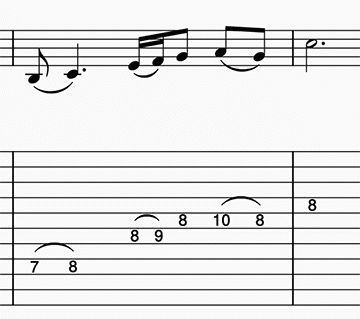Dynamic fret number alterations in linked tabulature for pedal steel guitar
REQUEST SUMMARY:
Enable accurate linked tabulature for pedal steel guitars by implementing visible tab fret number alterations, created via +/- keys.
FEATURE REQUEST:
Include linked 10-string tabulatures for common pedal steel guitar tunings (10-string E9 & C6) in Musescore, and allow alterations to individual tab fret numbers to be created using the +/- keys. String pitch alterations (+/- symbols) should display next to the fret number, and the fret number should also change accordingly (plus signs lower the fret number, minus signs raise the fret number). Pressing + should increment the alteration by 1, pressing - should decrement the alteration by 1, with a range of +3 to -3.

EXPLANATION:
The pedal steel guitar (PSG) most commonly uses a 10-string tabulature with 11 lines, with fret numbers entered in the spaces. Pedals and levers on the instrument allow individual string alterations of 1 or 2 (or, very rarely, 3) half steps up or down. Because of this, fret number indicators must be displayed with cues to indicate the pedal or lever movement.
At present this must be done entirely by hand using text and symbols placed on unlinked tab staves, an extremely tedious and error-prone process. (see previous discussion: https://musescore.org/en/node/106041)

Traditional PSG tab uses letters (ABCDEFG etc.) appended to the fret numbers to indicate which pedal or lever is being invoked (i.e. 5B, 8A, 10E). Highly personalized pedal & lever configurations ("copedents") prevent standardization of the pedal & lever labels. Normally a legend describing the functions of referenced pedals & levers for any given tab score is provided at the top of the chart.
• This would be prohibitively complicated to implement, requiring a user to register their unique copedent in a custom dialog so that the linked tabulature could translate the note alterations into ABCDEFG+ format. Not recommended for implementation.

Modern PSG tab prefers a method of simply indicating the raises and lowers with +/- symbols, with the presumption that each player knows their own copedent well enough to understand which pedal or lever should be used (i.e. 5+, 8++, 10-). No legend is needed for this system.
• This would be much simpler to implement in Musescore, by allowing the +/- keys to add one or two (or three) symbols to a given fret number indicator, and having the fret number adjust itself automatically.

IN PRACTICE:
I have set up a custom 10-string (11-line) linked staff+tab score for reference. In the "Edit String Data" window of the Staff Properties dialog I increased the number of strings to 10 and edited their pitches to the standard E9 tuning with a 24 fret range.
In the "Advanced Style Properties" window I set the offset to -0.85 to place fret numbers between the lines, as is normal for PSG tabulature. Marks are set to Numbers, drawn On Lines (then offset to appear below the actual string line). Clef (TAB) and barlines are shown, rhythms and time signatures are hidden. (see attached tab staff dialog windows)
Currently, notes entered on the staff appear in the linked tab automatically, although perhaps not on the intended string. Each number in the tab can be selected and dragged up or down to different strings as usual.
This feature request would then allow +/- alterations to be assigned to individual fret numbers as explained above. This would provide the ability to easily create accurate linked staff+tab notation for Pedal Steel Guitar in Musescore.
Thanks for reading! :)
PSG+TAB.mscz
| Attachment | Size |
|---|---|
| tab-staff-fret-marks.jpg | 81.6 KB |
| tab-staff-note-values.jpg | 87.48 KB |